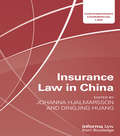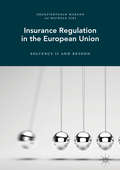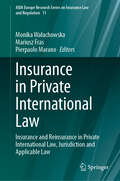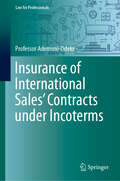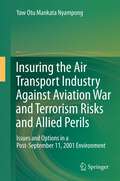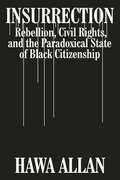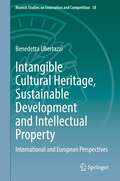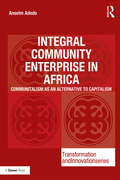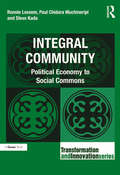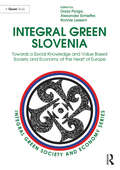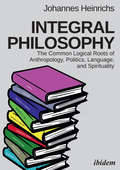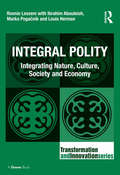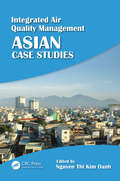- Table View
- List View
Insurance Law and the Financial Ombudsman Service (Lloyd's Insurance Law Library)
by Judith SummerInsurance Law and the Financial Ombudsman Service is an in depth look at the workings and insurance decisions of the Financial Ombudsman Service. The book analyses how the Ombudsman Service decides insurance cases and compares its approach to that of a court. This book sets out the rules, procedure and approach of the Ombudsman Service, succinctly summarises the relevant insurance law and compares and analyses it against a comprehensive review of material about insurance complaints gathered since the formation of the Ombudsman Service in 2001.
Insurance Law in China (Contemporary Commercial Law)
by Johanna Hjalmarsson Dingjing HuangThe Chinese insurance market is expanding enormously as risk adversity takes hold in the economy while the role of the State as guarantor of commerce is gradually reduced. In addition, insurance is a heavily regulated field with detailed contract law stipulations. An introduction to regulation and contract law and an understanding of current issues is essential for someone seeking to do business in the Chinese market. Insurance law is also a field that translates well from one jurisdiction to another, and academics will be interested in understanding how issues are dealt with in another jurisdiction. The book seeks to present and discuss current topics in Chinese insurance law and regulation to an English-speaking audience knowledgeable of common law insurance law and international insurance business. The combined effect of the papers is to present Chinese insurance law to an audience unfamiliar with Chinese law, in a readable and accessible essay chapter format. Each chapter is written by an expert in the field and goes beyond a basic introduction to provide in depth well-researched information and academic analysis on the topic in question.
Insurance Law: An Introduction (Practical Insurance Guides)
by Robert MerkinInsurance Law – An Introduction is essential reading and will provide you with a thorough understanding of all the main areas including motor, property, financial and marine insurance. The book contains the latest case law and best practice with reference to problem areas including fraudulent claims, third party rights against insurers and construing insurance terms. Comprehensive guidance on all key areas from the duty of utmost good faith to choice of law and jurisdictional issues is given by the leading legal experts in the insurance industry.
Insurance Law: Cases and Materials (Third Edition)
by Roger C. HendersonThis Third Edition includes many new cases and notes, as well as a thorough revamping of a number of sections and chapters. For example, Chapter 2 now brings together materials on fundamental assumptions of insurance law. A new Chapter 3 brings together a variety of materials on both judicial and legislative regulation of the insurance business. The authors designed this edition towards three primary goals: (1) To impart an understanding of basic insurance law through the cases and notes; (2) To raise fairly debatable, provocative issues, which will involve students in legal analysis and resolution; (3) To inform students about basic insurance business practices, as well as some of the more practical problems faced by attorneys, judges, and insurance regulators in the real world. The overall aim is to impart a sound foundation in law and legal analysis, an understanding of the business of insurance, and an appreciation of the role of insurance in modern society. The book is designed for either a three- or four-hour course in insurance law, but through some judicious editing it may also be used in a two-unit course.
Insurance Law: Text and Materials
by Ray HodginFirst published in 2002. Routledge is an imprint of Taylor & Francis, an informa company.
Insurance Regulation in the European Union
by Pierpaolo Marano Michele SiriThis book explores the profound transformation that has taken place in European insurance legislation since January 2016. Expert contributions discuss the changes that have taken place in the supervision of insurance and reinsurance undertakings through an economic risk-based approach. They outline the European insurance market before going on to show how Solvency II and Insurance Distribution Directive (IDD) are expected to generate significant benefits and have a positive impact on all parties involved in the insurance industry, the supervisory authorities and the insured. They also show how Solvency II is likely to benefit the economy as a whole, promoting more efficient allocation of capital and risk in a financial stability framework. This volume will be of interest to academics and researchers in the field of insurance regulation.
Insurance Settlements
by Ronald MillerInsurance Settlements Increase settlement values with this insider's guide to the insurance settlement process. Insurance Settlements opens long-locked doors to insurance claims departments, gathering the experience of more than 25 veteran claims managers, attorneys, medical experts, and adjusters. Discover in days what most plaintiffs' attorneys take years to learn. This book reveals how to: * Demonstrate to the adjuster that you know what you are doing * Determine when and what to say for maximum impact * How to help the adjuster sell your client's damages to his superiors * Draft effective demand letters * Evaluating soft tissue injuries * Break cases free from common logjams * Prove pain and suffering * Get realistic offers from adjusters * Counter common insurance settlement tactics * Value cases using traditional insurance company techniques * Obtain top dollar
Insurance and Human Rights (AIDA Europe Research Series on Insurance Law and Regulation #5)
by Birgit Kuschke Margarida Lima RegoThis volume examines the impact of and interplay between human rights and insurance. National, supranational and international legal instruments regulating the taking-up and pursuit of the business of insurance and reinsurance, (re)insurance distribution and the insurance contract often refer to or impact on human or fundamental rights. Courts are often faced with the sometimes seemingly impossible task of reconciling insurance core principles, practices and mind-sets with the principles and values stemming from human rights protection. In some cases, such as that of discrimination in insurance, this discussion has been going on for decades. Some deal with hot topics which have more recently emerged in light of developments stemming from technologic innovations (‘InsurTech’). The first part of the book focuses on insurance and the right to equal treatment. Discrimination on the basis of factors such as gender or age is tackled, from the perspectives of the European Union, Canada and South Africa. The second part of the book highlights the very relevant role played by insurance in the upholding of the right to health, covering the United States of America, Africa and Brazil. The third part of the book explores InsurTech's manifold challenges upon the right to privacy, focusing on European Union. The fourth part tackles the threat posed by insurance on the right to life in general, but with a particular focus on the United Kingdom. Written by legal scholars and practitioners, the book offers international, comparative and regional or national perspectives, aiming to contribute to a more thorough and systematic understanding of the interactions between these two very different fields of law, providing the industry as well as the scientific community with insights from both sides of this seemingly difficult to transpose divide.
Insurance in Private International Law: Insurance and Reinsurance in Private International Law, Jurisdiction and Applicable Law (AIDA Europe Research Series on Insurance Law and Regulation #11)
by Pierpaolo Marano Monika Wałachowska Mariusz FrasThis book provides a comprehensive analysis of jurisdiction and law applicable in cross-border insurance matters. The first book to address cross-border insurance cases from the perspective of European Union regulations, international conventions, and national laws applicable to insurance and insurance-related issues, it explores the concept of cross-border insurance issues and specific institutions related to insurance matters. In the process, it covers both classic private international law matters and specific issues, such as autonomous vehicles in cross-border cases, new technologies, and the Insurance Distribution Directive (IDD). Given its focus, the book offers a valuable asset for academics, judges, legal practitioners and insurance companies, and other institutions frequently dealing with cross-border insurance matters.
Insurance of International Sales' Contracts under Incoterms (Law for Professionals)
by Professor Ademuni-OdekeThe book deals with insurance of the 11 rules in Incoterms 2020 and under Common Law. Incoterms, cargo insurance and common law principles are the leading players in international commercial transactions. Although based on common law principles, Incoterms and cargo insurance practices have global application as all other legal systems and jurisdictions look to the common law for guidance. The book examines the importance of insurance in international commerce, extent of the parties’ insurance responsibilities at common law and under Incoterms 2020 Edition. Prior to detailed treatment of insurance aspects, it places the subject into perspective and context by including the wider, but related, discussions of the history, nature, property and risks transfers, as prerequisite background of the international sales contracts. Central to the book is focus on FOB and related Incoterms without sellers’ insurance responsibilities, in contrast to CIF/CIP Incoterms with sellers’ insurance obligations. It then proceeds to a wider investigation of the full extent of parties’ insurance responsibilities at common law and under Incoterms 2020.
Insurance, Climate Change and the Law (ISSN)
by Franziska Arnold-DwyerThe insurance industry has found itself at the front line of climate change challenges, providing insurance cover in relation to risks associated with climate change. As risk carriers, insurers pay claims for climate change related losses – such as property damage caused by windstorms, flooding, and wildfires – which have been increasing in frequency and severity.As major institutional investors, insurance companies invest in assets that may be increasingly vulnerable to climate risks. Insurance regulators across the globe have therefore started to require insurance companies to identify, manage, and report on climate change risks that could pose a threat to their financial stability. However, managing and reporting on the effect of climate risk on an insurer’s balance sheet is an inward-looking perspective that does not stem climate change. It needs to be paired with an outward-looking perspective that takes account of the insurance industry’s impact on the environment and the insurance industry’s capacity to influence what policyholders, investee enterprises, and other business partners do to address climate change challenges. For the insurance industry, the key components of positive outward impact are ‘impact underwriting’ and ‘impact investment.’ This book sets out the current legal and regulatory landscape for impact underwriting and impact investment. Whilst the focus of research and regulatory interventions to date has been on inward impact, in this book it will be argued that, to take positive climate action that supports the Paris Agreement goals and the national and international Net Zero targets, the debate should now move on to considering the positive outward impact the insurance industry can make and how we can create a legal environment to facilitate this.The book puts forward the case for a new vision of the role of the insurance industry as climate action enablers and makes proposals for insurance products and risk transfer and loss resilience structures that can support policyholders in their transition to a Net Zero economy. The audience for this book will include legal practitioners, insurance industry professionals, financial and insurance regulators, policymakers, and interested academics.
Insurgent Citizenship: Disjunctions Of Democracy And Modernity In Brazil (In-formation Ser.)
by James Holston<P>Insurgent citizenships have arisen in cities around the world. <P>This book examines the insurgence of democratic citizenship in the urban peripheries of São Paulo, Brazil, its entanglement with entrenched systems of inequality, and its contradiction in violence.<P> James Holston argues that for two centuries Brazilians have practiced a type of citizenship all too common among nation-states--one that is universally inclusive in national membership and massively inegalitarian in distributing rights and in its legalization of social differences.<P> But since the 1970s, he shows, residents of Brazil's urban peripheries have formulated a new citizenship that is destabilizing the old.<P> Their mobilizations have developed not primarily through struggles of labor but through those of the city--particularly illegal residence, house building, and land conflict. <P>Yet precisely as Brazilians democratized urban space and achieved political democracy, violence, injustice, and impunity increased dramatically.<P> Based on comparative, ethnographic, and historical research, Insurgent Citizenship reveals why the insurgent and the entrenched remain dangerously conjoined as new kinds of citizens expand democracy even as new forms of violence and exclusion erode it.<P> Rather than view this paradox as evidence of democratic failure and urban chaos, Insurgent Citizenship argues that contradictory realizations of citizenship characterize all democracies--emerging and established. <P>Focusing on processes of city- and citizen-making now prevalent globally, it develops new approaches for understanding the contemporary course of democratic citizenship in societies of vastly different cultures and histories.
Insurgent Collective Action and Civil War in El Salvador
by Elisabeth Jean WoodWidespread support among rural people for the leftist insurgency during the civil war in El Salvador challenges conventional interpretations of collective action. Those who supplied tortillas, information, and other aid to guerillas took mortal risks and yet stood to gain no more than those who did not. Wood's rich tapestry of explanation is based on oral histories gathered from peasants who supported the insurgency and those who did not over a period of many years during and immediately following the war, and interviews with military commanders of both sides. Peasants supported the FMLN, Wood found, not for any material gain that was contingent on their participation, but rather for moral and emotional reasons. Wood's alternative model places emotions and morals, as well as conventional interests, at the heart of collective action.
Insuring Cyberinsecurity: Insurance Companies as Symbolic Regulators
by Shauhin A. TaleshA free ebook version of this title is available through Luminos, University of California Press’s Open Access publishing program. Visit www.luminosoa.org to learn more. Despite the massive costs associated with data breaches, ransomware, viruses, and cyberattacks, most organizations remain thoroughly unprepared to safeguard consumer data. Over the past two decades, the insurance industry has begun offering cyber insurance to help organizations manage cybersecurity and privacy law compliance, while also offering risk management services as part of their insurance packages. These insurers have thus effectively evolved into de facto regulators—yet at the same time, they have failed to effectively curtail cybersecurity breaches. Drawing from interviews, observations, and extensive content analysis of the cyber insurance industry, this book reveals how cyber insurers' risk management services convey legitimacy to the public and to insureds but fall short of actually improving data security, rendering them largely symbolic. Speaking directly to broader debates on regulatory delegation to nonstate actors, Shauhin A. Talesh proposes a new institutional theory of insurance to explain how insurers shape the content and meaning of privacy law and cybersecurity compliance, offering policy recommendations for how insurers and governments can work together to improve cybersecurity and foster greater algorithmic justice.
Insuring the Air Transport Industry Against Aviation War and Terrorism Risks and Allied Perils
by Yaw Otu NyampongThis book explores the central problems underlying the insurance of aviation war and terrorism risks and associated perils. It critically analyses the reasons why conventional insurance markets are unwilling or unable to provide sustainable insurance coverage for aviation war and terrorism risks in the aftermath of catastrophic events such as the terrorist events of September 11, 2001. It also examines some of the prominent concepts proposed and/or implemented after 9/11 to determine whether and to what extent these concepts avoid identified pitfalls. Like many of life's essentials, the importance of insurance is most evident when it is not available. The sheer scale and magnitude of the insurance losses that followed 9/11 caused conventional insurance markets (which hitherto had been offering generous insurance coverage for aviation war and terrorism risks to air transport operators for little or no premium) to withdraw coverage forthwith. The ensuing absence or insufficiency of commercial insurance coverage for aviation war and terrorism risks has sparked a global search for viable and sustainable alternatives. Ten years have since elapsed, and despite numerous efforts, the fundamental problems remain unresolved. The book proceeds on the premise that the underlying issues are not entirely legal in nature; they have immense economic, psychological and policy implications that cannot be underestimated. A multidisciplinary approach is therefore used in examining the issues, drawing heavily upon analytical principles adapted from law and economics and behavioural law and economics. It is hoped that the resulting study will be beneficial not only to lawyers and those interested in aviation insurance but also to economists, air transport insurance program managers, capital market investors and governmental policymakers, both at the national and international levels.
Insurrection: Rebellion, Civil Rights, And The Paradoxical State Of Black Citizenship
by Hawa AllanA brilliant debut by lawyer and critic Hawa Allan on the paradoxical state of black citizenship in the United States. The little-known and under-studied 1807 Insurrection Act was passed to give the president the ability to deploy federal military forces to fend off lawlessness and rebellion, but it soon became much more than the sum of its parts. Its power is integrally linked to the perceived threat of black American equity in what lawyer and critic Hawa Allan demonstrates is a dangerous paradox. While the Act was initially used to repress rebellion against slavery, during Reconstruction it was invoked by President Grant to quell white-supremacist uprisings in the South. During the civil rights movement, it enabled the protection of black students who attended previously segregated educational institutions. Most recently, the Insurrection Act has been the vehicle for presidents to call upon federal troops to suppress so-called “race riots” like those in Los Angeles in 1992, and for them to threaten to do so in other cases of racial justice activism. Yet when the US Capitol was stormed in January 2021, the impulse to restore law and order and counter insurrectionary threats to the republic lay dormant. Allan’s distinctly literary voice underscores her paradigm-shifting reflections on the presence of fear and silence in history and their shadowy impact on the law. Throughout, she draws revealing insight from her own experiences as one of the only black girls in her leafy Long Island suburb, as a black lawyer at a predominantly white firm during a visit from presidential candidate Barack Obama, and as a thinker about the use and misuse of appeals to law and order. Elegant and profound, deeply researched and intensely felt, Insurrection is necessary reading in our reckoning with structural racism, government power, and protest in the United States.
Intangible Cultural Heritage, Sustainable Development and Intellectual Property: International and European Perspectives (Munich Studies on Innovation and Competition #18)
by Benedetta UbertazziThis book critically analyses the relationships between intangible cultural heritage (ICH), sustainable development and intellectual property rights (IPRs). The author argues that although the use of IPRs to safeguard ICH presents challenges and has impeded sustainable development in some cases, the adoption of these rights on ICH also presents opportunities and, fundamentally, is not contrary to the spirit of the UNESCO Convention for the Safeguarding of the Intangible Cultural Heritage (UNESCO 2003 Convention). The adoption of IPRs on ICH can form an important part of the development of sustainable safeguarding plans capable of benefitting the communities, groups and individuals (CGIs) that create, maintain and transmit such heritage. The book provides a nuanced analysis of the relationship between intellectual property (IP) law and ICH as well as examining the role of IPRs in safeguarding ICH through the lens of sustainable development. It analyses the relationship between IP law and ICH from environmental, social and economic perspectives. These perspectives allow a thorough evaluation of both the positive effects and potential pitfalls of adopting IPRs to safeguard ICH. The book addresses deeper structural matters that refer back to the safeguarding of social and environmental processes underlying ICH.
Intangible Intangibles: Patent Law's Engagement with Dematerialised Subject Matter (Cambridge Intellectual Property and Information Law)
by Brad ShermanThis book takes as its starting point recent debates over the dematerialisation of subject matter which have arisen because of changes in information technology, molecular biology, and related fields that produced a subject matter with no obvious material form or trace. Arguing against the idea that dematerialisation is a uniquely twenty-first century problem, this book looks at three situations where US patent law has already dealt with a dematerialised subject matter: nineteenth century chemical inventions, computer-related inventions in the 1970s, and biological subject matter across the twentieth century. In looking at what we can learn from these historical accounts about how the law responded to a dematerialised subject matter and the role that science and technology played in that process, this book provides a history of patentable subject matter in the United States. This title is available as Open Access on Cambridge Core.
Integral Community Enterprise in Africa: Communitalism as an Alternative to Capitalism (Transformation and Innovation)
by Anselm AdodoAt a time of global economic crisis and disillusionment with capitalism, Adodo offers refreshing and positive insight into a more integral way of business management, enterprise and community development as well as holistic healing in Africa. For over three decades, Africa was the recipient of billions of dollars in aid funds that were meant to catapult the continent from undeveloped to developed status. Yet the more the aid poured in, the poorer African countries became. The devastating effect of western economic models in Africa that followed is well documented. Integral Community Enterprise in Africa exposes the limitations of existing theories, such as capitalism, socialism and communism, and shows how western theories were imposed on Africa. Such imposition of concepts and ideas is not only demeaning but also unsustainable, serving only the interest of the elite. Father Anselm Adodo argues for the need to have a southern theory to serve as an alternative to western theories. The majority of African intellectuals and activists, while criticizing existing theories, often do not provide alternative theories to address the prevalent inadequacies entrenched in conventional social, political and economic systems. This revolutionary book aims to address this lapse and proposes the theory of communitalism as a more indigenous, sustainable and integral approach to tackling the social, political, economic and developmental challenges of today’s Africa. There is an African alternative to capitalism, socialism and communism – a surer path to sustainable development in and from Africa. This is a book that is positioned at the very core of a much needed African Renaissance. A profoundly new approach to development in Africa, this is essential reading for anyone concerned with authentic development in Africa and in the world.
Integral Community: Political Economy to Social Commons (Transformation and Innovation)
by Ronnie LessemIntegral Community moves the transformation journey for enterprises and society on from the stages covered in earlier books in Gower's Transformation and Innovation Series, which describe a new macro-economic framework and which have examined alternative development with different local communities, bringing wide cultural perspectives to practical implementation of authentic or integral development. Here, the authors argue that there are two major fields of force prevailing in today's world. The one reflects our common heritage, whereby East and West, North and South are coming ever closer together - the global commons. The other reflects local and national singularity, where the notion of feeding off ancient local heritage and talent is key. They also identify four different culturally laden worldviews as Southern - humanistic, Eastern - holistic, Northern - rational, and Western - pragmatic. The enterprise and social innovation in Africa with which Lessem's co-authors are involved provides an object lesson in the sort of differentiation and integration needed in order to operate, socio-economically, with local identity and global integrity. It provides in this case a 'Southern' worldview background against which to examine communally based self-sufficiency; culturally based developmental economy; knowledge based social economy; and finally, the move towards what the authors describe as a living economy. All illustrated through a rural case, Chinyika, with which they have been intimately involved, whereby 100,000 have become self sufficient over the past five years. Integral Community should be read by academics and students of business, economics, development studies and agriculture, and by policy makers, particularly those concerned with the developing world in general and Africa in particular.
Integral Development: Realising the Transformative Potential of Individuals, Organisations and Societies (Transformation and Innovation)
by Ronnie Lessem Alexander SchiefferAlexander Schieffer and Ronnie Lessem introduce a groundbreaking development framework and process to address the most burning issues that humanity faces. While conventional top-down, outside-in development has reached a cul-de-sac, a new, integral form of development is emerging around the world. Integral Development uniquely articulates this emergent approach, and invites us to fully participate in this process. The integral approach has been researched and framed over decades of in-depth experience in transformative development education and practice all over the world. It uniquely combines four mutually reinforcing perspectives: nature and community; culture and spirituality; science, systems and technology; and enterprise and economics. Conventional development theory and practice has prioritized the latter two perspectives, neglecting the former two. This has caused massive imbalances in today’s world. The four interconnected perspectives allow for a transformative and integrated engagement with core development issues in a way that is locally relevant and globally resonant. Throughout, the practical impact of Integral Development is brought to life through highly innovative cases from around the globe, drawing on the authors` first-hand experience. This makes the book a living demonstration of the power of this pioneering approach. Integral Development shows how individual, organizational and societal developments need to be interconnected to release a society’s full potential. It shifts the responsibility for large-scale development from often-distant experts and organizations to each individual, community, enterprise and institution within the society. It is essential reading - and a call to action - for everyone concerned with the current state of local and global development.
Integral Green Slovenia: Towards a Social Knowledge and Value Based Society and Economy at the Heart of Europe (Integral Green Society and Economy)
by Ronnie Lessem Alexander Schieffer Darja PicigaRonnie Lessem and Alexander Schieffer's Integral Green Society and Economy series has three overarching aims. The first is to link together two major movements of our time, one philosophical, the other practical. The philosophical movement is towards what many today are calling an 'integral' age, while the practical is the 'green' movement, duly aligned with that of sustainable development. The second is to blend together elements of nature and community, culture and spirituality, science and technology, politics and economics, thus serving to bring about an 'integral green' vision, albeit with a focus on business and economics. As such, the authors transcend the limitations to sustainable development and environmental economics, which are overly ecological, if not also technological, in orientation, and exclude social and cultural elements. Thirdly, this particular volume, with Darja Piciga, focuses specifically on Slovenia, as well as on Europe generally, drawing on the particular issues and capacities that this country and continent represents, particularly for sustainable development and social knowledge-based economy. The emphasis on Slovenia arose, not only because it lies at the heart of Europe, but because a specific movement for an Integral Green Slovenian Society and Economy, has been co-evolved there, by the three editors in conjunction with Slovene organisations, communities and movements, with a view to integrating existing and emerging knowledge resources, initiatives and practices into a model, as an alternative to austerity, for Slovenia and other European countries.
Integral Philosophy: The Common Logical Roots of Anthropology, Politics, Language, and Spirituality
by Johannes HeinrichsThis cumulative course on Johannes Heinrichs’s philosophical works presents the essence of his previous publications: a rich, consistent, and novel monolithic system defying temptations by the zeitgeist. Starting with an emphasis on reflection as the basis of epistemology, Heinrichs also covers the mind-body dualism in an anthropology chapter, moves on to presenting summaries of his theory of democracy as well as his philosophical semiotics, followed by an outline of structural and integral ontology. An overview of ethical positions in the final chapter proves the fertility of Heinrichs’s theoretical-reflection methods.Heinrichs (born 1942 in Duisburg/Rhine, Germany) developed a “reflection system theory” which is an original up-to-date development of German idealism, inspired by the multi-value logic of Gotthard Günther. His reflection theory of language presents an alternative to the current language analysis as well as to Chomsky’s way of universal grammar. By his systematic approach, he opposes the mere historicism of most Western philosophers, also by the spiritual character of his very methodical philosophy. In spiritual respects, he is near to Sri Aurobindo.
Integral Polity: Integrating Nature, Culture, Society and Economy (Transformation and Innovation)
by Ronnie Lessem Ibrahim Abouleish Louis HermanReleasing the genius of an individual, an enterprise and a society is a central pre-occupation of the contemporary business environment. A fascinating approach to how we can begin to tackle this challenge is presented by the authors of Integral Polity. Integral spirituality, integral philosophy and the integral age, at an overall or holistic level of consciousness, has therefore become a strong enough idea to form the genesis of a movement over the course of the last half century. Taking as a starting point the ground-breaking work of the Trans4m Centre for Integral Development this book applies such an ’integral’ notion to the realms of business, economics and enterprise. To be successful, an integral approach must recognise the nuances of its environment - an integral approach in India is different from that in Indonesia, or Iceland, and they may in fact complement rather than conflict. Therefore this book also provides a fascinating alignment of such ’integrality’ with, and between different ’southern’ and ’eastern’, ’northern’ and ’western’ worlds. Using case studies ranging across the globe this review of a newly integral theory and practice provides a new lease of life to what may increasingly be perceived as the self-seeking, insulated and occasionally violent and corrupt, realm of the political.
Integrated Air Quality Management: Asian Case Studies
by Nguyen Thi Kim OanhThe steady growth in the number of vehicles on the road, heavy reliance on coal, use of dirty fuels for residential combustion, and extensive open burning are some of the major factors leading to the progressive deterioration of air quality in developing countries in Asia. And despite efforts to establish and implement air quality measurement syste

